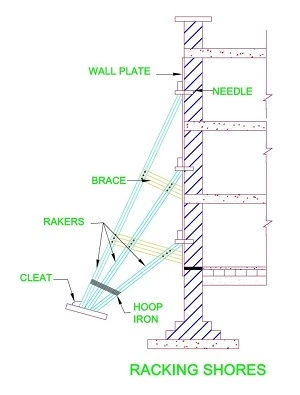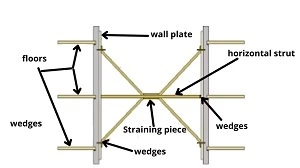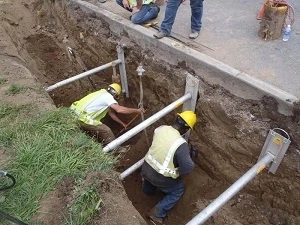Shoring is one of the excavation safety procedures used to protect the edges of an excavation to prevent cave-in or collapse of the excavation.
Generally, shoring could be used to provide lateral support:
- To walls undergoing repair or reinforcement.
- During excavations.
- To prevent walls from bulging out.
- When an adjacent structure is to be pulled down.
- When openings in a wall are made or enlarged.
Some materials that can be used for shoring include: Timber, structural steel, and framed tubular scaffolding.
Before we get back to shoring excavation, let us consider the different shoring techniques:
Shoring Techniques
Common Excavation Shoring Techniques
-
Hydraulic Shoring: This technique uses hydraulic pistons that are pumped outward to press against trench walls. It is quick to install and remove, and offers excellent protection in trenches with unstable soil.
-
Timber Shoring: Traditional and effective, timber shoring uses wooden beams and planks to support trench walls. It is often used in deeper or irregular excavations where prefabricated systems may not fit.
-
Pneumatic Shoring: Similar to hydraulic shoring but powered by compressed air, pneumatic systems are also adjustable and suitable for varying trench depths and widths.
-
Aluminum Hydraulic Shoring: Lightweight and easy to handle, aluminum systems are pre-engineered and allow for fast setup, making them ideal for short-duration excavations.
-
Trench Boxes (Shielding): Though technically not a shoring method, trench boxes are protective systems placed in the trench to shield workers in case of collapse. They are commonly used in utility installations.
An important safety aspect of shoring is its role in ensuring regulatory compliance. OSHA and other occupational safety bodies mandate protective systems in trenches exceeding certain depths. Non-compliance can lead to legal penalties, work stoppages, or even fatalities.
Proper excavation shoring also stabilizes nearby structures and utilities, especially in urban areas. When executed correctly by trained professionals, shoring protects not only the workers but also the integrity of the worksite.
Some Practical Shoring Approaches
- Raking shore: This involves the use of rakers, typically placed at 3-4.5 m centres, and braced at regular intervals. They tend to be inclined between 40-75º.

- Dead Shoring or Vertical Shoring: These are primarily used to carry vertical loads from walls, roofs, and floors. This is often required when an opening is being made in a wall, or a defective load-bearing wall is being rebuilt. An arrangement of beams and posts supports the structural weight and transfers it to the firm ground foundation.
- Flying shoring or Horizontal shoring: Flying shores are used as an alternative to raking shores and provide a clear working space at ground level by exerting thrust on opposite walls, often the party walls of two buildings. Often this is used in combination with ranking shore principles.

Going back to our main point of concern, “Shoring excavation”, from the different shoring techniques explained above, it is very obvious that the flying/horizontal shoring technique is what suits the excavation.
How to do Shoring for Excavation
This implies making use of one or more of the shoring techniques to safeguard an excavation.
Note: Shoring is used when the location or depth of the cut makes sloping back to the maximum allowable slope impractical.
Shoring systems consist of posts, wales, struts, and sheeting. Let’s move on to consider the types of shoring available at our disposal.
Types of shoring for excavation
There are two basic types of shoring for excavation:
- Timber shoring and
- Aluminum hydraulic shoring
Timber shoring
As the name implies, timber showing makes use of timber to prevent the collapse of the excavation.
Hydraulic shoring

The hydraulic shores are a prefabricated strut and/or wale system manufactured of aluminum or steel. Hydraulic shoring provides a critical safety advantage over timber shoring because workers do not have to enter the trench to install or remove hydraulic shoring.
Other advantages of most hydraulic systems are that they:
- Are light enough to be installed by one worker;
- They are gauge-regulated to ensure even distribution of pressure along the trench line;
- Can have their trench faces “preloaded” to use the soil’s natural cohesion to prevent movement; and
- Can be adapted easily to various trench depths and widths.
Hydraulic shoring should be checked at least once per shift for leaking hoses and/or cylinders, broken connections, cracked nipples, bent bases, and any other damaged or defective parts.
To do shoring for excavation, you have to first determine the type of shore you want to use – Timber shoring or Hydraulic shoring. After determining the type of shoring you want to use, make the materials available, then get trained personnel to fix it up for you.
You can equally learn how it is done.
NOTE: There must be a routine inspection plan for any shoring type adopted. This will help prevent failure of the structure.
The Safety Aspect of Excavation Shoring: A Critical Construction Practice
Excavation shoring is a vital safety practice in construction that involves supporting the walls of a trench or excavation to prevent soil collapse and protect workers from cave-ins. Shoring is not just a technical procedure—it is a life-saving measure that plays a central role in excavation safety, especially when digging trenches deeper than 1.2 meters (4 feet), where the risk of collapse becomes significant.
One of the primary safety benefits of excavation shoring is its ability to prevent trench wall collapse. Trenches can become unstable due to soil type, water content, vibrations from nearby machinery, or weather conditions. Without proper support, these factors can cause sudden soil movement, trapping or burying workers in seconds. By using shoring systems such as hydraulic shoring, timber shoring, or aluminum trench boxes, construction teams can create a safer working environment and significantly reduce the likelihood of such accidents.
Another important safety aspect of shoring is its role in ensuring regulatory compliance. Occupational safety authorities, such as OSHA in the United States, require that employers protect workers in trenches through systems like shoring, sloping, or shielding. Non-compliance can lead to severe penalties, legal liabilities, and reputational damage. More importantly, adherence to these standards safeguards workers’ lives and promotes a culture of responsibility and safety on-site.
Proper excavation shoring also improves site stability for adjacent structures and utilities. In urban or developed areas, excavations may occur near buildings, roads, or underground pipes. Inadequate support can result in ground shifts that affect these structures, potentially causing costly damage or secondary hazards. A well-designed shoring system minimizes such risks and contributes to overall project safety and efficiency.
To be effective, shoring systems must be designed and installed by qualified professionals who understand the soil conditions, depth, and type of excavation. Regular inspections and maintenance are also essential to ensure continued stability throughout the project duration.
In conclusion, excavation shoring is not just a technical necessity—it is a fundamental aspect of construction safety. It protects workers from life-threatening hazards, ensures compliance with legal requirements, and supports the integrity of surrounding structures. Investing in proper shoring practices demonstrates a commitment to worker safety and project success, making it an indispensable part of modern construction operations.
Related Articles
11 Best Excavation Safety Procedures (Excavation Safety)
What Are The Deadliest Excavation Hazards You Need To Know?
30 Safety Requirements on a Construction Site
What Is the Online Permit To Work System and Examples
A seasoned Health and Safety Consultant with over a decade of hands-on experience in Occupational Health and Safety, UBONG EDET brings unmatched expertise in health and safety management, hazard prevention, emergency response planning, and workplace risk control. With a strong passion for training and coaching, he has empowered professionals and organizations to build safer, more compliant work environments.
Certified in globally recognized programs including NEBOSH, ISO standards, and OSHA regulations, he combines technical know-how with practical strategies to drive health and safety excellence across industries. designing comprehensive HSE management systems or delivering impactful safety training, whether he] is committed to promoting a culture of safety and continuous improvement.
